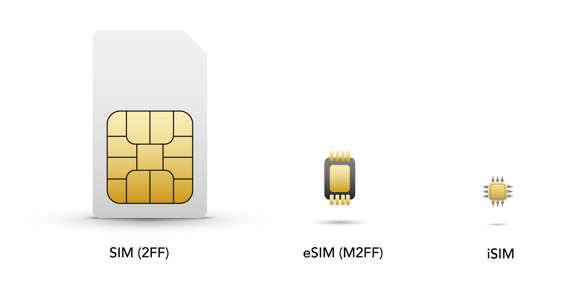

While SIM, eSIM, and iSIM all perform the same core function, their differences impact device functionality, security, and scalability. Knowing these distinctions can help you optimize and future-proof your IoT devices.
What can you find in this article?
- What is a SIM?
- What is an eSIM?
- What is an iSIM?
- How are SIMs, eSIMs, and iSIMs different?
- Which SIM is best for your deployment?
What is a SIM?

A SIM is a Subscriber Identity Module. It’s an integrated circuit component that has its own operating and file system.
The SIM securely stores information needed to authenticate and access a mobile network, such as private keys, security algorithms, and identifiers such as the International Mobile Subscriber Identity (IMSI).
SIM cards require a slot in the device and are removable, which allows someone to reuse their SIM card in another device or install a new card to access different networks.
SIMs in the embedded form factor are soldered onto the device or module - and are not removable.
When comparing traditional SIM form factors and embedded SIMs - the embedded SIM prevents theft of the SIM, as well as provides better physical characteristics in terms of shock and corrosion resistance.
On the other hand, traditional SIM form factors can be physically changed in case a SIM swap is required.
Disadvantages of a SIM
Traditional SIMs - no matter if they are embedded or have a standard plastic card form factor - have several disadvantages.
In cellular IoT, one of the biggest disadvantages of traditional SIMs is that they come pre-programmed with a single identity, with a fixed functionality available on the SIM card at the time of production.
In the consumer case, humans have access to the SIM card (usually on their phones or tablets) and can change it if needed. But for cellular IoT, the devices are usually in the field at a customer site - making it very difficult if not impossible to physically swap SIM cards.
With this in mind, any updates or changes that unfold after the SIM production can impact the service availability, for example, the shutdown of radio technologies like 2G and 3G, or changing roaming partnerships and regulations.
All of these problems can be mitigated by using an embedded SIM.
What is an eSIM?

An eSIM comes with technology and software that can remotely provision carrier profiles without having to swap out the physical card or chip inside the device.
With consumer devices such as smartphones and tablets, the eSIM is often referred to as just a software profile that is downloaded via a QR code.
For IoT devices, the eSIM is still a physical card or embeddable module - so the embedded SIM comes in all the form factors as standard SIMs.
From a technical perspective, the embedded SIM that is used in typical IoT devices is referred to as M2M eUICC, as standardized by the GSMA.
M2M eUICC comes with a standard that makes it possible to manage, download, enable, disable and delete carrier (Mobile Network Operator) profiles over the air.
Advantages of an embedded SIM
Embedded SIMs have several key advantages over traditional SIM cards. First and foremost, they can be provisioned with a new profile OTA.
Traditional SIM cards are stuck with the same functionality that was available at the time of production.
With the embedded SIM OTA functionality, the embedded SIM can:
- receive new profiles with different network coverage,
- enable new radio technologies like 5G and cellular over satellite (NTN), or
- be updated with additional smart functionality.
This vastly improves your device’s ability to adjust to a changing environment and ensures that your SIM is connected for as long as your device's lifetime.
Disadvantages of an embedded SIM
From a technical perspective, there is no disadvantage of an embedded SIM compared to a standard SIM. Everything a SIM can do, the embedded SIM can do as well and better.
As one of the newest, most advanced SIM technologies, embedded SIMs are more expensive than traditional SIM cards and not all devices can make use of the over-the-air update capability, e.g. devices that are unable to receive an SMS.
What is an iSIM?

An iSIM is an Integrated Subscriber Identity Module. It’s essentially a more advanced embedded SIM. It provides the same functionality, but you don’t have to solder it onto the device’s circuit board.
Instead, an iSIM has a dedicated space on the System of Chip (SoC), where it’s protected by a Tamper Resistant Element (TRE).
Integrated SIMs continue the tradition of making cellular components smaller and more efficient, and on the wireless module it is just a fraction of the size of an MFF2 (embedded SIM), which is already substantially smaller than a traditional SIM card.
Advantages of an iSIM
An iSIM has the same advantages as an embedded SIM: it’s more durable and tamper-proof, it can change carriers OTA (thanks to its eUICC capability), and because it’s even smaller than an embedded SIM and built right into the SoC, it has virtually no impact on your device’s design.
Since the iSIM is built into the chipset, you don’t actually even have to install it. No soldering necessary. The operator profile will be provisioned on the module during the chipset manufacturing. At scale, this can help you manufacture and deploy devices faster.
Disadvantages of an iSIM
Currently, iSIMs aren’t in widespread use. This is the newest SIM technology on the market, and so the chipsets and modules that are iSIM capable are limited.
How are SIMs, embedded SIMs, and iSIMs different?
The main differences between the three lie in size and security.

Size
The most obvious difference between the SIM, embedded SIM, and iSIM is size. Smaller SIM formats give you greater flexibility when it comes to designing your device, and in some applications, building smaller, more discrete devices may be essential (such as surveillance or healthcare).
Additionally, embedded SIMs and iSIMs are always going to cost more than traditional SIM cards. They’re more complex and advanced, which makes them more expensive to produce and develop with.
However, this upfront cost can save you the monumental cost (or disruption to your business) of having to physically replace SIM cards down the road.
Security
The fact that a traditional SIM card can be physically removed from a device makes it easy to steal—a common occurrence globally, happening countless times each day.
Embedded SIMs and iSIMs are inherently harder to steal, enhancing the security and integrity of the devices they power. iSIM takes this a step further, building on the security of traditional SIM and eSIM by residing in a secure enclave on the device’s system-on-chip (SoC).
This setup provides a root of trust for the network through an added layer of authentication, which is particularly valuable in applications like payments, identity verification, and critical infrastructure.
Which SIM is best for your deployment?
While the iSIM hasn’t been implemented at scale yet, IoT manufacturers still have a range of options when it comes to SIM form factors. When choosing the best SIM solution for your application, consider these key factors:
- Sizing limitations
- Cost of the final product
- Need for remote provisioning
- Importance of certification
By evaluating these factors and working out which ones make the most sense for you, you can choose the SIM solution that fits your IoT deployment, ensuring long-term connectivity, security, and adaptability.

Bronwyn Hemus
With a career spanning over 18 years in storytelling and content creation, Bronwyn translates technical concepts and ideas into snackable and easy-to-digest content.



